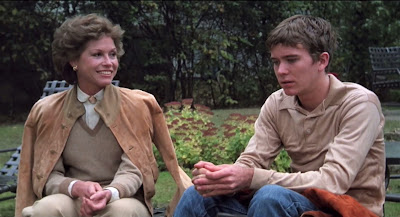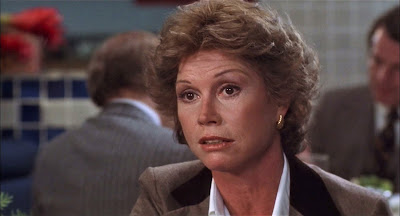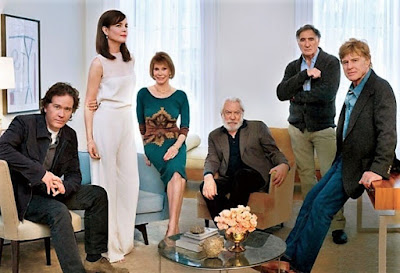As a youngster, it seemed
as though I became interested in movies about grown-ups at precisely the time Hollywood
became fixated on making movies about youngsters. In 1967 when I was about
10-years old, Hollywood, having opened its eyes to the newfound autonomy and boxoffice clout
of teenagers and the college crowd, set about aggressively courting the youth
market. Then still an industry run by old men who were, at best, only superficially aware of what the youth market even wanted, Hollywood
nevertheless flooded movie theaters with all manner of what was presumed to be youth-themed product. A significant
number of these films being devoted to hippies and social rebellion.
My personal apathy towards movies about young people and kids my own age wasn't born of any specific dislike for my peers so much as it was reflective of how badly at the time I wanted to be an adult. I was still at an age where I went to movies for escapism, and, what with having three teenage sisters lording over me at home 24/7, the last thing I wanted to do in my away time was to spend hours in a dark theater looking at more teenagers...or worse, adults pretending to be teenagers. It didn't help, either, that I grew up in the vicinity of San
Francisco’s Haight/Ashbury district during the peak of its Summer of Love popularity; the proximity and ubiquity of so many real-life hippies sufficiently killing any mystery or allure they might have otherwise held for me on the big screen.
 |
| The dry rivers of Los Angeles popularized the postwar craze of hot rod drag racing. The LA River was used for drag racing scenes in numerous films, among them: Girls Town (1959) and Grease (1978) |
No, I wasn't interested in the "happening" younger generation movies of the day like Woodstock, Alice’s Restaurant, or Zabriskie Point. The movies I longed to see were those I thought would offer a glimpse into what my overactive and melodramatic imagination fancied the world of grown-ups to be like: Two for the Road, Hotel, Valley of the Dolls, Reflections in a Golden Eye. But, alas, I was at that awkward age: a cinephile "tween" too old for Walt Disney but too young for Ken Russell.
Paradoxically, while young people in contemporary films held little interest for me on the big screen, on the black and white console TV in our family’s living room, I was positively gaga over movies about teenagers from the ‘50s and early ‘60s. On Saturday afternoons local TV stations could be relied upon to supply a steady stream of ‘50s juvenile delinquent melodrama (The Violent Years - 1956); hot rod exploitation (Dragstrip Riot - 1956), rock & roll romance (Rock, Rock, Rock - 1956); jukebox musicals (Don’t Knock the Rock - 1956); low-budget monster movies (I Was a Teenage Frankenstein -1957), screwy sci-fi flicks (Teenagers from Outer Space - 1959); and Drive-in oddities (Teenage Caveman - 1958).
 |
| Kids Just Wanna Have Fun |
These poor-relation follow-ups to Brando’s The Wild One (1953), Dean’s Rebel Without a Cause (1955), and Poitier’s Blackboard Jungle may have been marketed to teens, but in favoring harmless generation gap clashes over social rebellion commentary, their narratives always hewed close to the middle-class status quo. Juvenile delinquents were never depicted as anti-heroes whose mistrust of authority was justified, rather, they were seen as atypical bad apples and stand-alone troublemakers. Their disobedience was often shown to be the pitiable product of broken homes or of having been raised without the proper advantages (aka, a suburban home with a white picket fence).
 |
| Moderne Family: Jeanne Tatum, Jody Fair, and Kirby Smith bask in the Streamline furniture, starburst clocks, wall sconces, and enormous coffee tables |
Known in our house as "juvies" (juvenile delinquent movies) or "black & white shoe pictures" (in reference to the bobbysoxer footwear-of-choice: saddle-shoes), the movies in this genre I most enjoyed were those distinguished
by their non-existent budgets, prodigious use of bop-talk slang, and the then-vanguard
preponderance of rock & roll music on the soundtrack. (Predictably, the vision
of America presented in these movies was unrelentingly white, save for the occasional, controversial appearance of an African-American rock & roll music act).
What used to really fascinate me—especially given that, at the time, these movies were only about 10 or 13
years old—was their jarring “otherness.” In everything from hair, speech
patterns, modes of dress, music, dances, and choice of leisure pastimes; these
movies depicted a teenage world so alien to life as I knew it, it was like our TV set was receiving transmissions
from another planet. Compared to the real-time preoccupations of the day (the
Vietnam War, civil rights, lowering the voting age, free love, drugs, Women’s Lib, and religious exploration) the '50s restlessness brought about by the Bomb and the Cold War seemed positively quaint.
 |
| Attack of the Well-Behaved, Appropriately-Dressed, Party Crashers |
While some of these films were sincere in their efforts to call attention to the delinquency crisis hitting the suburbs at the time, most were conceived as exploitation programmers pandering to the teen preoccupations of the day, and geared for quick turnover in the Drive-In market. The silliest, ergo, the most entertaining of this ilk were the programmers that played out like dry-runs for the yet-to-come Beach Party movies of the sixties. These films had nonsensical plots, an almost vaudeville approach to humor, stock teen characters (the bland hero, his loyal “girl,” the jokester, the bad kids/rivals), and the elders were always well-meaning allies, ineffectual authority figures, or comic buffoons.
A particular favorite I made a
point never to miss whenever it cropped up on TV was Ghost of
Dragstrip Hollow; a goofy titled, likeably awful goulash of teen-movie tropes economically crammed into a brisk 65-minutes...which made it perfect for those 2-hour afternoon TV programs whose hosts served up jokey commentary between the countless commercials.
Top on my list of reasons why Ghost of Dragstrip Hollow rocks is that the only rebellious drag racing done in the entire film is by the women
 |
| Jody Fair as Lois Cavendish |
 |
| Nancy Anderson as Annita (Nita) |
The almost surreally silly Ghost of Dragstrip Hollow was
promoted as a sequel (of sorts) to 1959’s more straightforward Hot Rod Gang, but newcomers to this film needn’t worry
about not being able to pick up the thread. There isn’t one.
Remember that list of ‘50s teen
flick genres I referenced earlier? Well, Ghost of Dragstrip Hollow somehow manages
to be ALL of them at once. Yes, in a mere 65 minutes you get juvenile
delinquent melodrama, hot rod exploitation, rock & roll romantic comedy, a rockabilly
and girl-group pop jukebox musical of (all the better to promote American
International Pictures’ newly-formed record label), a ghost/monster flick, and a Scooby Doo mystery, to boot.
 |
| Members of The Zenith Motor Club Amelia (Sanita Pelkey), Dave (Henry McCann), Bonzo (Leon Tyler), and Rhoda (Elaine DuPont) |
The Zenith Club is a group of suburban hot rod enthusiasts devoted to disaffirming the public perception of hotrodders as street-racing, authority-flouting, juvenile delinquents. Pledged to a strict code forbidding street racing of any kind, this clean-cut clique spends its time tinkering with engines and bop dancing in the adjacent soda shop. Journalist Tom Hendry (Russ Bender), writing a human interest article on teenagers called “This Restless Breed,” has been invited to tag along as the Zeniths do whatever it is they do. A plot contrivance opening the door for a lot of exposition and the reciting of more hot rod minutiae than any of us deserve.
The leader of The Zeniths is Stan (Martin Braddock), a wholesome, cardigan-wearing type characterized by his level-headedness and never being seen doing anything remotely car-related. Other members include pint-sized brainiac Dave (Henry McCann) and his bookish, Amazonian gal-pal Amelia (Sanita Pelkey); annoying, comedy-relief cut-up Bonzo (Leon Tyler) and kewpie-eyed girlfriend Rhoda (Elaine DuPont); and real-life drag racing Hall of Famer Tommy Ivo (as himself...and perhaps wondering, like me, why he isn’t the leader of the club) and his mostly silent, ponytailed partner Sandra (Judy Howard). A welcome break from all this gender stasis (the women don’t really do anything in the club except stand around watching their boyfriends work on engines) is Lois Cavendish (Jody Fair).
Lois is the only female hotrodder and mechanic in the club, and, as she’s so easily goaded into “chicken run” drag races by Nita (Nancy Anderson), a snarly rival gang member, she’s also the film’s only rule-breaker (albeit, reluctant). Refreshingly independent-minded for a film of this sort, Lois has her interest in cars trivialized (“I can dig the male of the species, but the female hotrodder baffles me!”) and boyfriend Stan laments her not placing him first in her passions (“She prefers hot rods instead of hot romances”), yet she persists. Even when it comes to her parents.
 |
| "You're approaching womanhood...." "I've got news for you...I've arrived!" |
When The Zenith’s lose their clubhouse lease, elderly eccentric
Anastasia Abernathy (Dorothy Neumann) kindly grants the kids use of her late
grandfather’s deserted house in Dragstrip Hollow…provided the youngsters can
rid the place of a skulking monster and spooky ghost. And it’s at this point—roughly, some three-quarters into the movie, mind
you—that Ghost of Dragstrip Hollow finally
decides it might be time to actually be about a ghost of Dragstrip
Hollow. Good idea. Especially since up to now the movie’s mostly been a series
of vaguely connected false leads and narrative fake-outs designed to quash dramatic
conflict (or story momentum, for that matter) every time it rears its head.
Among the many introduced-only-to-be-abandoned plot points: the whole gang rivalry angle; Lois’ generation-gap clash with her parents; Tom’s forgotten magazine article; the chance that Lois’ involvement in hot-rodding could adversely affect her father’s real estate business; and boyfriend Stan’s concern that he comes second to Lois’ love of fast cars.
 |
| Dorothy Neumann as Anastasia Abernathy - with Alphonso, her loquacious parrot. Fans of The Andy Griffith Show might recognize Neumann as the wife of Otis, the town drunk |
Among the many introduced-only-to-be-abandoned plot points: the whole gang rivalry angle; Lois’ generation-gap clash with her parents; Tom’s forgotten magazine article; the chance that Lois’ involvement in hot-rodding could adversely affect her father’s real estate business; and boyfriend Stan’s concern that he comes second to Lois’ love of fast cars.
But that’s no reason to despair. Not when there’s so much
time devoted to slumber parties, bop dances, lengthy musical interludes, a
wisecracking parrot, the invention of the smart car, and a wrap-up so hasty you’ll
think you nodded off and missed something.
WHAT I LOVE ABOUT THIS MOVIE
If ever there was a movie to exemplify the principle of
making a virtue of one’s flaws, that movie is Ghost of Dragstrip Hollow. Proof
that a deficit of production values and a meandering screenplay is no match for
an appealing cast and a rockabilly soundtrack. Revisiting this film after so
many years, I was certain that personal nostalgia would play the most
significant role in determining how I would respond. But imagine my
surprise to discover that Ghost of Dragstrip Hollow—in all its nonsensical, unpretentious
glory—still rocks!
And I don’t mean just in a campy, Mystery Science Theater 3000 way, either (although it has that to
spare). I don’t know what it is, but there’s something so inoffensively featherweight
and ridiculous about the whole premise and execution of this film that getting
caught up in its jaunty good nature proves rather effortless. I actually found
myself laughing with the film as
often as I was laughing at it.
What once felt like an “otherness” in the film’s setting and
characters, now feels recognizably old-fashioned. Like a mash-up of Scooby-Doo, The Munsters, Father Knows
Best, American Bandstand, and
those “Abbott and Costello Meet…”
movies.
Although it sounds like faint praise, the cast of Ghost of Dragstrip Hollow wins me over with
their likeability more than their talent, the latter ofttimes proving to be a downright
obstacle in movies like this. The older players fare best, what with the
younger ones at constant risk of being upstaged by a wisecracking parrot. Jody
Fair makes for a pleasantly spunky leading lady, but whenever bespectacled, statuesque
Sanita Pelkey appears in the scene, I can’t imagine anyone’s eyes being on
anyone else.
 |
| A former Miss New York and onetime showgirl, Sanita Pelkey appeared on a 1958 episode of the Groucho Marx game show You Bet Your Life (audio only) |
DIG THAT CRAZY BEAT:
American International Pictures, an independent movie studio that would make a name for itself in the '60s and '70s (not a particularly good one) with their Beach Party movies and biker flicks, was one of the first to mine the lucrative boxoffice potential of teenagers. In 1959 they launched their own record label, and the songs from Ghost of Dragstrip Hollow (most written by Beach Boys producer Nick Venet) were among the first to be pressed. I'm happy to say I have them all in my collection. Perhaps I should be mortified.
 |
| Rockabilly band "The Renegades" perform Geronimo and Charge! and Ghost Train |
 |
| The girls of the Zenith Motor Club badly lip-sync to a song titled My Guy. The song was released as a 45 single by a group calling themselves "Linda Leigh and the Treasure Tones" |
 |
| Jimmie Maddin sings "Tongue Tied." Maddin was a singer/saxophonist and nightclub owner in LA. He was still performing at one of his clubs (The Capri Club in Glendale) a year before he died in 2006 |
GINCHY* GLOSSARY:
From a narrative standpoint, Ghost of Dragstrip Hollow is a bit of a hodgepodge. But its silly/funny dialogue and overemphatic slang is the ginchiest. (*ginchy means cool)
“Put the cork, York.” —Please be quiet
“He’s got static in
his attic. Completely zonk!” —He knows not whereof he speaks
“My dragon wagon’s
laggin'” —My automobile is in need of a tune-up
“It’s PM-ing, I’d
better peel out”
“Put that thing down,
Dad. Before you clobber your clavicle.”
“Two weeks on the slab? That’s a real buffalo.” —Grounded? That's distressing news
“This gal’s got what
it takes. If she’d only give it.”
“Somebody get this bag of bacteria lost.” —I'm afraid we haven't been introduced
“It’s not a chop, kitten. I purr you. Why, I’m not just makin’ sound waves. Like, if you weren’t jacketed, I’d move in.’Cause you’re a dap…I mean a real dap!”
—I'm being sincere, I like you. If you weren't already spoken for I'd ask you out, because I find you quite dapper
(A parent confronting two kids necking)
“We thought we’d come
out for a breath of fresh air”
“Where’d you think
you’d find it? Down her throat?”
“I dreamed I was an 18-cylinder motor. It was wonderful...you should have seen my driveshaft!”
“That was grandmother Aphrodite!”
“How’d she die, trying to spell that name?”
BONUS MATERIAL:
 |
| Available in its entirety on YouTube |





















































